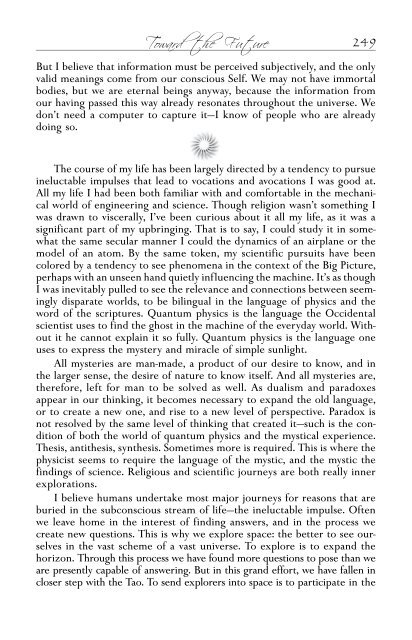edgar-mitchell
edgar-mitchell
edgar-mitchell
Create successful ePaper yourself
Turn your PDF publications into a flip-book with our unique Google optimized e-Paper software.
Invisible Realities 125<br />
other hand, has always believed that consciousness is fundamental, and<br />
that internal visions, voices, and insights are absolutes to be taken literally—<br />
messages from The Great Beyond. Their meanings were obvious. As a result<br />
of this historical, though artificial division of viewpoints, beliefs about<br />
the nature of the universe have become more entangled, complex, and<br />
torturous to reconcile, though each has certain evidence to support the<br />
viewpoint. Paradoxes abound, with the entire edifice of our knowledge<br />
resting upon two fractured, incomplete, competitive, and teetering foundations—physical<br />
measurement and mystical insight—largely because there<br />
has not been an acceptable model for mind and consciousness.<br />
Today mathematical models of reality require a multidimensional universe<br />
and an ineffable quantum reality in order to make a strong, but less<br />
than complete picture. Interpretations of quantum mathematics by the<br />
most eminent of scientists require a phalanx of observers to “collapse the<br />
wave function” of the universe to its existing state. Mystical models require<br />
a spirit world, a hierarchy of angels, deities, and demigods ascending<br />
to heaven, and a progression of levels descending to hell such as that represented<br />
in Dante’s Divine Comedy. Both scientific and religious models seem<br />
a bit strained, having to make outrageous claims to account for the mysteries<br />
of our world. As I pondered this, it reminded me of what would have<br />
happened had the makers of our Apollo spacecraft not consulted each other<br />
during design. Nothing would have fit when they finally assembled the<br />
various components. Science and religion have a similar problem with regard<br />
to the interface between them.<br />
But there are alternative models of reality, and it wasn’t long after my<br />
return from the moon that I began to actively assemble my own. I saw that<br />
if we allow certain mind attributes to be fundamental to the processes of<br />
the universe, with mathematics as creation of mind—a language—and if the<br />
mystic allows that visions, voices, and insight are simply information the<br />
mind needs to interpret, then the artificial, but historical division between<br />
mind and matter suddenly collapses, and the most perplexing paradox in<br />
both camps evaporates; the dualism is resolved. The universe begins to<br />
look again like the universe we inhabit. The problem is one of giving interpretation,<br />
meaning, to information. It is the story of quantum mechanics<br />
that serves to illuminate these issues.<br />
Centuries ago, long before the days we now associate with the genesis of<br />
quantum physics, a great debate was taking shape. In the time of Galileo,<br />
astronomers who had fashioned glass lenses from sand and peered at the<br />
world around them saw how the instruments were capable of shaping light<br />
and magnifying objects. The question that troubled these first astronomers<br />
and early thinkers was that light seemed most easily described mathematically


